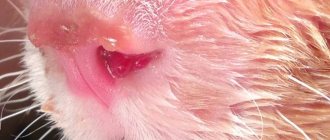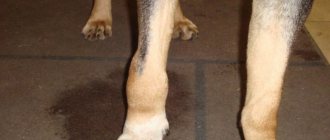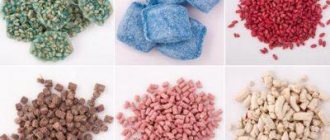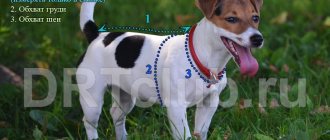Causes and varieties
The following types of bleeding in dogs are distinguished:
- External - occurs due to wounds and is detected upon examination.
- Internal: characterized by bleeding into a cavity or tissue.
- Mixed - a combination of external and internal.
Depending on the type of damaged vessel, capillary, venous or arterial bleeding appears. Arterial hemorrhage is considered the most dangerous. In this case, the scarlet liquid gushes out. In a short time, the dog can die due to massive blood loss.
Venous blood is dark red in color because it is saturated with carbon dioxide. The blood in the capillaries is mixed, so its color is red. Hemorrhages are not abundant and in most cases go away on their own.
Internal bleeding is divided into obvious, when in this case the blood comes out through the mouth, loop, nostrils, anus, and hidden. The latter can be cavity or interstitial.
Suspicions of office bleeding arise when indirect signs appear: shortness of breath, pallor of the mucous membranes, fatigue. With hemorrhages in the abdominal cavity, the stomach swells before our eyes. Interstitial bleeding leads to bruising and hematomas.
The following types of internal bleeding are distinguished:
- Pulmonary: occurs as a result of an accident, heart disease and cancer in older dogs. Blood is found in cough sputum, discharge from the nose or mouth.
- Vomiting: with esophageal bleeding, red blood is found in the expelled masses. A coffee-ground colored mass indicates gastric bleeding.
- Intestinal hemorrhage is detected by examining stool. A dark, tarry mass indicates the influence of enzymes in the initial section of the intestinal tube. Dark red color indicates the destruction of venous, and bright red - arterial vessels of the final section of the rectum. Bloody diarrhea indicates poisoning or an infectious disease.
- Hematuria - bloody urine occurs when the kidneys or bladder are inflamed.
- Nasal bleeding develops due to injury.
Common sites of bleeding in dogs
Below we consider some of the most common locations of bleeding:
- From the nasal cavity. When the walls of blood vessels are damaged, during a bruise or injury, nosebleeds occur. It can be short-term and long-lasting up to several days. In the latter case, it leads to anemia of the animal. Blood drips or flows from the nasal cavity. May stop temporarily, but then reappear;
- When gums and teeth are damaged. Injuries to the mouth lead to tooth loss and excessive bleeding. The nature of the flow depends on the size of the affected area;
- Damage to the eyelids. This localization of the wound is not dangerous for the dog, but can lead to scarring, and this is fraught with eversion of the eyelid and other visual impairments. Wounds of the eyelid are accompanied by damage to the skin, cartilage or muscles. The most important thing is to protect the dog from contamination and infection entering the open affected area;
- Uterine bleeding. Occurs in females after a period of estrus, i.e. Heavy bleeding begins. They also occur after childbirth and can last up to 12 weeks. The danger lies in large blood loss, and, as a result, the development of anemia in the animal. In case of serious heavy blood loss, you should immediately show the dog to a veterinarian;
- In feces. The appearance of blood in a dog's stool may be due to damage to the rectal mucosa, or hard stool containing undigested bone debris. In old pets, the appearance of blood may be associated with the presence of hemorrhoids, fissures, and cancerous formations. When an animal's stool becomes dark in color, this already means intestinal bleeding and requires surgical intervention;
- In urine. Injuries to the bladder, kidneys and urinary organs lead to bleeding. However, if your dog's urine has a reddish tint, it may be a feeding pattern rather than bleeding. For example, an animal ate beets or carrots. Or, due to taking certain medications, the urine has changed its natural color. The main signs of blood in the urine include frequent and painful urination. Moreover, in some cases, bleeding is not accompanied by any signs and does not cause concern to the dog;
- Minor wounds, bites and cuts. They heal quickly on the dog, without outside intervention. Extensive scalped wounds, when large flaps of skin dangle, are best sutured. In such cases, it is necessary to contact a veterinary clinic as soon as possible to avoid infection of the wound.
What are the dangers of bleeding?
Scanty one-time hemorrhages do not cause harm to health. However, if minor bleeding occurs constantly, anemia develops. Bleeding from the arteries is life-threatening. Constant blood loss leads to malnutrition of the skin, kidneys, liver, brain, and heart.
With a loss of 40 to 70% of blood, the prognosis for recovery is questionable; if more, it is unfavorable. In some situations, surgical intervention is required to stop internal bleeding.
Treatment
In order to stop bleeding in a dog, the doctor must know the exact cause of the pathological condition. Next, depending on the established factors, treatment tactics are developed.
Main points of treatment:
- Infusion of infusion solutions - to maintain pressure in the arteries and increase the perfusion of tissue structures. Internal bleeding in a dog in the chest or abdominal cavity provokes the development of a state of shock in the animal. Many important systems of the body are affected.
- Infusion of red blood cells (transfusion of components and whole blood). Necessary for severe anemic conditions and large blood losses in the dog.
- Abdominal ligation. Applying a bandage or tightening is necessary to increase pressure inside the abdominal cavity. This slows down the process of large blood flow from the arteries.
- Oxygen therapy. Required for bleeding with large volumes of blood, especially in the first stages. The pet is placed in a special box into which oxygen is supplied. Oxygen therapy is also performed using a special mask or an oxygen catheter.
- Pain relief. Severe pain in the animal is eliminated by administering potent painkillers. Sedation may be required due to the animal's anxiety.
- Hemostatic drugs. The administration of vitamin K (Vikasol) and its analogues is necessary in the first hours of bleeding.
Treatment of a dog with mass formations in the abdominal cavity involves emergency surgery. Laparoscopy is performed - a minimally invasive technique that allows not only to diagnose the condition of the abdominal organs, but also, if necessary, to eliminate the main cause of hemorrhage.
First aid
In case of arterial bleeding, an Esmarch tourniquet or a rubber tube with a twist is applied and taken to the clinic. If a vein is affected, apply a pressure bandage. Place a folded bandage on top of a sterile gauze pad and bandage it tightly. If the damage is minor, they are treated with a wound-healing antiseptic spray, which acts as a gauze-free dressing. Minor wounds will heal on their own after the dog licks them.
How to help your pet at home
If your dog has bloody stool, don't panic. It is important to provide all possible assistance to your pet at home. In the case of a short-term form of pathology, it is possible to independently treat the dog with the following means:
- antispasmodics, which will relieve pain and reduce spasms of the colon;
- activated carbon, which removes accumulations of toxins from the body;
- lactobacilli, normalizing the condition of the colon;
- decoctions and tinctures made from blueberries, chamomile and oak bark, which help cope with the inflammatory process.
If stool disorder with blood clots no longer bothers the dog, experts recommend giving your pet a small portion of boiled rice instead of food. The portion should be small. Boiled rice porridge will need to be fed to the dog throughout the day (in 4 meals). Gradually, the portion can be increased if the dog’s health improves. In addition, it is necessary to give the dog rice water every 2-3 hours, which will help fix the stool.
It is also recommended to give your pet fermented milk products in small amounts, but often. The therapeutic diet will need to be followed for several days. As soon as the stool becomes normal and there are no more blood clots in the bowel movements, it will be possible to return familiar foods to the animal’s menu.
Advice! Before going to the vet when your Toy Terrier (or another breed) poops blood, you can give your dog a chamomile or nettle infusion, which has hemostatic properties, to drink.
Oak bark tincture, which can be easily prepared at home, will help cope with bacteria.
To eliminate the consequences of intoxication, it is necessary to use sorbents
To reduce the load on the gastrointestinal tract, you should put your pet on a starvation diet. If the sick animal has an appetite, you can give it a small amount of soft and light food. During illness, it is better to avoid dry food.
When emergency veterinary care is needed
Most often, the dog owner is able to stop the bleeding. However, in the following cases, your pet will require emergency veterinary care:
- external bleeding does not stop for a quarter of an hour or more;
- blood does not come out from the wound, but the losses turned out to be high, shortness of breath occurred, the mucous membranes became pale, the eyes became cloudy, the dog became weak;
- traces of hemorrhage were detected in urine or feces;
- vomiting of blood occurred;
- bleeding from the loop began;
- the stool has acquired a tarry consistency;
- blood does not flow out, but the state of health has worsened, the stomach is swollen, the mucous membranes have turned white;
- eyes are red;
- hematomas occurred.
Dogs are rarely injured, but the owner of the animal must be prepared to provide first aid in case of bleeding, and also maintain mobile communication with a veterinarian.
How to check for internal bleeding in a dog
Internal bleeding in animals can be obvious or hidden. In the first case, you can detect it yourself, but only a qualified veterinarian can confirm the diagnosis. If the bleeding is hidden, its independent detection is possible only with careful monitoring of the dog’s condition.
With obvious bleeding, all the fluid enters the gastric cavity or interstitial space. If the problem is related to vascular disorders in the stomach, intestines and lungs, blood appears in the animal’s saliva when coughing. The mass released during vomiting is similar to coffee grounds. In addition, blood is noticeable in stool and urine.
It is much more difficult to detect hidden bleeding. It is necessary to carefully monitor the dog's condition. You should be wary if you notice shortness of breath, bloating, excessive fatigue, decreased activity and pallor of the mucous membranes. Elastic hematomas appear on the bends of the knees. Eyes turn red.
Internal bleeding can be accurately determined by a thorough external examination by a veterinarian, a puncture, and an abdominal x-ray. The latter type of laboratory test detects the presence of fluid in the stomach, but is not able to accurately determine its type.











